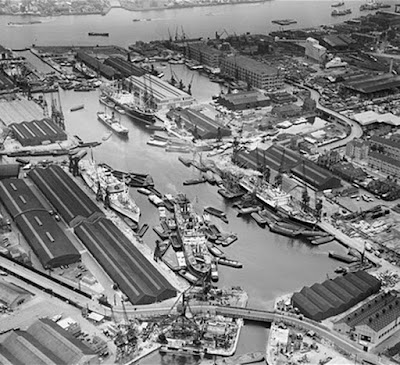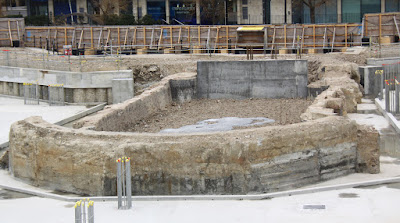 |
Coonatto by Thomas Goldsworth Sutton
National Maritime Museum PY8564 |
Coonatto was a three-masted clipper commissioned from the partnership of Thomas Bilbe and William Perry in 1863 by Anderson, Thompson and Co. (later Anderson, Anderson and Co.) for the Orient Line for the transport on their London to Adelaide route of cargo, mainly wool, and passengers.
The relationship between Thomas Bilbe and Anderson, Thomson and Co. began when Bilbe built a ship named
Celestial for James Thomson, using a patented system of wooden hull framing. The ship was a great success and led to the contracts with Anderson, Thompson and Co., the founders of the Orient Line, for the London to Adelaide (Australia) route. Other ships built by Bilbe for the Orient Line included
Orient, Borealis, Yatala, and
Argonaut (click on the links to see my previous posts about these ships). The Orient Line. A lovely description of the Orient Line ships survives from an 1898 article by John Arthur Barry:
As a good instance of how the sailing lines changed into steam, there existed in the sixties a fine fleet of small clippers trading to Adelaide for wool. The largest of them all was the Orient, of some 1200 tons or so. Then came the Murray, Goolwa, Yatala, Coonatto, Derra, etc., fast, fine-lined, London-built vessels of from 800 to 1000 tons, speedy but wet. Indeed, it was said of them that they took a dive on leaving the Channel, came up at the Cape for breath, and did not reappear until Kangaroo Island was in sight. This was perhaps an exaggeration, but their skippers drove them for all they were worth, and carried their main-top-gallant sails when other vessels had their upper topsails off; also imagined the world was coming to an end, or that Australia had disappeared, if they couldn't find Cape Borda in anything under eighty days.
 |
Coonatto in Adelaide. From the Trove website, PRG 1373/2/6
at trove.nla.gov.au |
The Orient Line became the Peninsula and
Orient Steam Navigation Company, which eventually became re-branded as the very familiar P+O. By the time that
Coonatto was built, Bilbe had moved on to a new and innovative method of hull construction: composites. He patented and trialled composite ship construction with the clipper
Red Riding Hood in
1857, and all ships after this one built by Thomas Bilbe were composites. Composite ships were built with a mixture of wood and iron. The
iron frame and ribs reinforced the hull and meant that the structure
could be more open, providing additional room for cargo.
Coonatto was the first ship that Bilbe built for the Orient Line. She was a composite clipper, a method of construction that
Coonatto was 160ft 2in long with a 29ft beam.
Coonatto's entry in the 1874-75 Lloyds register provides basic
information about the ship's build but also mentions an interesting
addition to the ship's equipment when, in 1874, she was provided with
felt and ‘yellow metal’ cladding. The Citizan website says that traces of the cladding still remains
attached to some of the exposed timber. It sounds as though this was
similar to the copper hull cladding that protected ships against the
effects of wood-consuming species and improved the speed of ships
through the water. A similar modification can be seen on the restored
tea clipper
Cutty Sark in Greenwich, which has had the so-called Muntz alloy fastened to the entire hull.
 |
| Orient Line passages, March 1870 |
She was known as a fast ship, described by Basil Lubbock as "an out and out clipper with very fine lines." Lubbock says that she was "very wet," which means that she took a lot of water on board when under sail, but he thought that this might be due "to the hard-driving of her skipper, Begg, a Highlander, who never spared her and made some very smart passages out and home."
Coonatto's fastest times were 66 days to the Semaphore Lightship and a
70-day run, even after losing both her helmsman and the wheel overboard
after broaching-to (falling foul of the wind) off St Paul's Island!
Clippers were mainly cargo carriers, although the Orient Line also carried passengers. The clippers on the Australian run were transporting a mixture of products to London, but primarily wool in exchange for a variety of British products. Basil Lubbock describes the shipping trade from Adelaide, which was the focus of only two or three firms, as follows: "During the sixties and seventies, when Sydney and Melbourne were filling their harbours with the finest ships in the British Mercantile Marine, Adelaide, in a smaller way, was carrying on an ever increasing trade of her own, in which some very smart little clippers were making very good money and putting up sailing records which could well bear comparison with those made by the more powerful clippers sailing to Hobson's Bay and Port Jackson." He goes on a little later: "Their captains, however, were always keen in rivalry and put a high value on their reputations as desperate sail carriers. They made little of weather that would have scared men who commanded shops of three times that tonnage of the little Adelaide clippers, and they were not afraid of a little water on deck."
The Trove website has a rather wonderful advert for Orient Line passenger places on clipper ships heading to various destinations in March 1870
. Coonatto was one of the ships heading for Adelaide under the command of Captain J.N. Smart. Two other ships listed on the advert,
Orient and
Yatala, were also built by Bilbe for the Orient Line (see my post about her here).
White Eagle, another ship on the list, was also owned for a time by Bilbe and his business partner William Perry, which was actually built in Aberdeen in 1855.
The South Australian Advertiser 8th October 1870. Shipping News (with thanks to the Trove website) provides this rather nice description of Coonatto leaving Australia for London:
COONATTO, for London via Port Augusta.
"The
Orient liner Coonatto has once more taken departure from the port by
towing over the bars on Thursday evening. It was Captain Smart's
intention to have immediately sailed for Port Augusta, where she is to
complete her wool landing; but during the night there was little or no
wind; therefore the ship remained at anchor awaiting a favorable change.
. . . The Coonatto weighed anchor in the roads on Friday afternoon, and
presented a very handsome appearance as she beat away on a sea breeze. Towards nightfall the wind hauled more off the land and enabled her to lay a course clear of Troubridge."
 |
The remains of Coonatto today
Copyright MOLA (Museum of London Archaeology) |
In 1876, carrying a cargo of copper,
copper ore and wool to England from Australia, she became beached in the English Channel at Crowlink, near Beachy Head, and could not be re-floated. At the age of 13 she was wrecked. The wreck is thought to remain at the foot of the white cliffs. The Citizan website provides a good description of the find:
Situated in the Seven Sisters and Birling Gap park lies the wreck of what is believed to be the Coonatto, a London registered bark-rigged clipper (a type of three-masted ship) that sources suggest ran aground in 1876. The wreck lies on the very edge of the intertidal zone, below the cliffs at Crowlink. The keel and starboard side of the ship are still clearly visible where they came to rest. The remains include large and small timbers, some still clad in a zinc alloy, whilst the total length of the wreck is roughly 43m bow to stern. The site is subject to the erosive forces of the waves and tides. Interestingly records describe the salvaged cargo being craned onto Crowlink Cliffs but given the present location of the cliffs and the type of cargo to be craned this suggests considerable erosion since the wrecking. The CITiZAN team hope that more research will establish the extent of the cliff that has disappeared and further understanding of the vessel. To date we have worked with partners and volunteers in the National Trust and Eastbourne Heritage Services as well as training the first 15 CITiZAN volunteers in England to work on this site. A plan of the site has now been produced with future focus on more detailed drawings of the diagnostic elements of the ship that survive as well as an attempt to generate a 3D model of the site to provide those who cannot make the journey to the site with the chance to learn more about this fascinating wreck.
There is apparently a painting in the Seaford Museum in East Sussex that is thought to show
Coonatto foundering at Crowlink, but I have been unable to find an image of it.
John Arthur Barry, writing in 1898, watched the demise of sail in favour of steam:
In the great mail steamers of that same Orient line that now lie alongside Circular Quay you may at any moment see the evolution of canvas to steam in its widest and most complete and final aspect. Other fleets, as the White Star one, for instance, have not quite yet arrived at the termination of the process, and still own a few sailers out of the fine array of once famous Aberdeen liners—-the Damascus, Patriarch, Thermopylae, and others, such as the Centurion, Abergeldie, Maid of Judah, Windsor Castle, Nineveh, etc., whose names, as well as those of the Duthie's and Thompson's, are indissolubly bound up with the early maritime history of the colony. Now and again, perhaps, in one of the harbor bays, you may see a shapely old craft whose aspect seems in some way friendly and familiar, only that she flies a foreign flag, and has a foreign name upon the stern. Dirty, weather-beaten, forlorn as she is, with rusty rigging and paintless spars, nothing can disguise the old ocean aristocrat who a score of years ago was the pride of her captain, the crack clipper of her fleet and whose comings and goings were matters of moment, both on this side of the world and the other one.
 |
The 6ft (1.83m) figurehead from
Coonatto now in the Jervis Bay
Maritime Museum
(Photo from the Jervis Bay
Maritime Museum website) |
As far as I know, Thomas Bilbe did not make the transition to constructing steam ships, which seems odd as he was certainly an accomplished engineer. He certainly didn't do so in Rotherhithe. It would be interesting to know what he did next, because he was clearly a very colourful character and it would be good to know more about him. If you have any details about his life, please do get in touch.
Sources for this post:
John Arthur Barry 1898. How the Wool Went Home Long Ago. Australian Town and Country Journal, Sydney, NSW. Saturday, December 17, 1898
http://gutenberg.net.au/ebooks13/1301811h.html
Basil Lubbock 1975. The Colonial Clippers. Brown, Son and Ferguson Ltd.
Charles F. Morris 1980. Origins Orient and Oriana. Teredo Books
Stuart Rankin 1996. Shipbuilding in Rotherhithe - The Nelson Dock.
Websites:
Jervis Bay Maritime Museum
http://jervisbaymaritimemuseum.blogspot.com/2014/03/figurehead-on-show.html
http://jervisbaymaritimemuseum.blogspot.co.uk/2016/01/wreck-of-caonatto.html
The Citizan.org website:
http://www.citizan.org.uk/resources/key-zones/south-east/wreck-coonatto-crowlink-birling-gap/
The MOLA Facebook page
https://www.facebook.com/MOLArchaeology







































